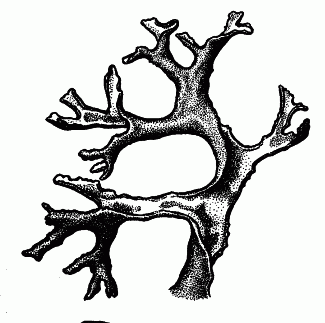Click on the image below to view an
expanded illustration for this species.

|
General:
Common Name: The Bone Lichens. Stresses the hollow lobes of the species and the pale, often whitish, upper cortex.
Small to medium stratified foliose lichens, corticate above and below, sorediate or rarely isidiate or not, lobes rather loosely appressed to semi-erect or pendulous, hollow, occasionally perforate, 0.5–5 mm wide. Upper surface usually pale greyish, occasionally brownish. Lower surface blackish, shiny, wrinkled, lacking rhizines. Medulla white. Photobiont green.
Apothecia located over upper surface, often stalked/stipitate, disc usually concave, brown; spores simple, spherical to ellipsoid, colourless, 8 per ascus.
Notes: Hypogymnia is essentially a temperate genus of about 50 species worldwide. Twenty species occur in North America and 17 in B.C. The western Hypogymniae display a highly varied chemistry and spot tests are helpful in distinguishing between species. Note that what is usually referred to as a PD- medullary reaction in Hypogymnia may sometimes actually be discerned as PD+ pale yellow. In this case, however, the coloration is usually restricted to the upper portion of the medulla, while the lower portion remains white. By contrast, a “true” PD+ pale yellow reaction (e.g., as for H. rugosa) registers across the entire medulla, from top to bottom. Applying as little reagent as possible will help avoid ambiguity. Brodoa oroarctica was formerly treated within Hypogymnia.
Species description:
Soredia present (check lobe tips) AND
Soredia located on upper surface (including upper surface of lobe tips) AND
Lobes not distinctly swollen, lacking basally constricted marginal lobules (lobules may, however, sometimes be present over upper surface); lobe tips generally not perforate; medulla PD-; variously distributed AND
Lobes appressed to substrate, elongate to more often rather short, usually crowded; upper surface plane; soralia variously positioned; inland AND
Outermost soralia larger, densely packed with finely granular/farinose soredia; soredia rare toward thallus centre, arising through disintegration of upper cortex; over bark; infrequent
Reactions:
Cortex K+ yellow; medulla KC+ red.
Contents:
Atranorin and physodic acid.
Source: Lichens of British Columbia |

